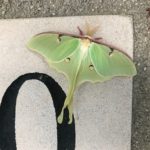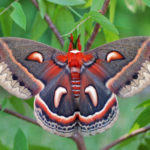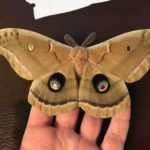By Casey Smith, Naturalist
I have a very understanding husband. I have completely repurposed a piece of furniture in our house. You probably have a similar piece in your house. It’s the one where all your stuff goes when you come home – backpacks, coats, keys. It holds the clean but not yet folded laundry. It is rarely used for its intended purpose. For us it’s the dining room table.
In summertime, that table becomes a haven for several species of praying mantis, and tons of caterpillars. Then, through the winter, I store the cocoons and various egg cases in the garage to overwinter. My kids get a kick out of watching the caterpillars grow, feeding the mantids, and releasing the moths when they emerge. My husband helps in collecting leaves and insects for the daily feedings. In its own unconventional way, raising these bugs has become a hobby my whole family can appreciate.

Currently on said table, I have Luna, Polyphemus, and Cecropia moth caterpillars. I know you’ve seen a Luna moth. They’re the bright green ones with the swallow tails. They are named for the moon shaped spots on their wings.
The Polyphemus is named after the cyclops of the same name from Greek mythology. They have large eye spots on their wings and have been compared to an owl’s face when turned upside down.
The Cecropia is the largest moth in North America with a wing spread of 5-7 inches.

All these moths are in the Saturniid family and they are some of the biggest and most beautiful moths in Ohio. What I find most impressive about them is their life cycle. Everyone has seen a caterpillar and wondered what it was going to turn into. But it’s the process of turning into its adult form that is really fascinating. Moth caterpillars spin a cocoon, while butterflies have a chrysalis. Inside the cocoon, the moth is in its pupal stage. What went in as a caterpillar completely breaks down into a goo and emerges as a moth. That is an amazing transformation.

My fascination with mantids, that also live on my dining room table, is their stealth. They have these intelligent faces and you can almost see them thinking when stalking the fly I’ve put in the enclosure. My family is raising three different species of mantids this year. To read more about my love for mantids, check out one of my earlier blog posts titled Mantis Mayhem.
So, if you see me out collecting leaves or stalking a bug, know that I’m taking those home to feed to all the critters living on my dining room table.






